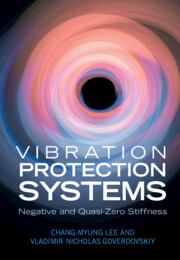Book contents
- Vibration Protection Systems
- Vibration Protection Systems
- Copyright page
- Contents
- Preface
- Acknowledgments
- Glossary
- 1 Vibrations Destroying Human–Machine Systems Inside and Outside
- 2 Vibration Protection Systems with Negative and Quasi-Zero Stiffness
- 3 Modeling of Elastic Postbuckling in Large and Dimensioning the Mechanisms with Negative Stiffness
- 4 The Type and Number Synthesis of Function-Generating Mechanisms
- 5 Dynamics of Systems with Sign-Changing Stiffness
- 6 Dynamics of Systems with Sign-Changing Stiffness
- 7 Dynamics of Systems with Sign-Changing Stiffness
- 8 Methods of Experimental Study of Vibration Protection Systems with Negative and Quasi-Zero Stiffness
- 9 In Harmony with Conventional Vibration Protection Systems
- 10 Development and Use of Vibration Protection Systems with Negative and Quasi-Zero Stiffness
- Index
- References
9 - In Harmony with Conventional Vibration Protection Systems
Published online by Cambridge University Press: 29 October 2021
- Vibration Protection Systems
- Vibration Protection Systems
- Copyright page
- Contents
- Preface
- Acknowledgments
- Glossary
- 1 Vibrations Destroying Human–Machine Systems Inside and Outside
- 2 Vibration Protection Systems with Negative and Quasi-Zero Stiffness
- 3 Modeling of Elastic Postbuckling in Large and Dimensioning the Mechanisms with Negative Stiffness
- 4 The Type and Number Synthesis of Function-Generating Mechanisms
- 5 Dynamics of Systems with Sign-Changing Stiffness
- 6 Dynamics of Systems with Sign-Changing Stiffness
- 7 Dynamics of Systems with Sign-Changing Stiffness
- 8 Methods of Experimental Study of Vibration Protection Systems with Negative and Quasi-Zero Stiffness
- 9 In Harmony with Conventional Vibration Protection Systems
- 10 Development and Use of Vibration Protection Systems with Negative and Quasi-Zero Stiffness
- Index
- References
Summary
Some types of conventional mechanical, pneumatic or other vibration protecting mechanisms with parametric elements of positive stiffness, i.e. having a given load capacity, may reveal the negative or quasi-zero stiffness in small. However, this is considered as a side effect and have no engineering feasibility to be realized in commercial vibration protection systems. This disadvantage can easily be eliminated if join the redundant mechanisms with parametric elements of negative and quasi-zero stiffness in large. Redundant mechanisms can drastically improve the quality of vibration protection in a certain combination and interaction with commercial systems, and without a destroying the system workspace. In this manner, one may arrange a seat suspension, independent wheel suspension, cabin's mounting, table or platform for measuring instrument and in this way protect a man-operator or passenger, power unit, onboard or stationary electronics, and cargo container. It was shown that the mechanisms with negative and quasi-zero stiffness in large, being properly joined to commercial vibration protection systems by using transmissions with short kinematic chain, increased 5 to 57 times the quality of vibration protection in the whole infra-low frequency range including nearly zero values. In some practical cases, this advantage reaches 100 to 300 times and more
Keywords
- Type
- Chapter
- Information
- Vibration Protection SystemsNegative and Quasi-Zero Stiffness, pp. 238 - 263Publisher: Cambridge University PressPrint publication year: 2021
References
- 1
- Cited by

